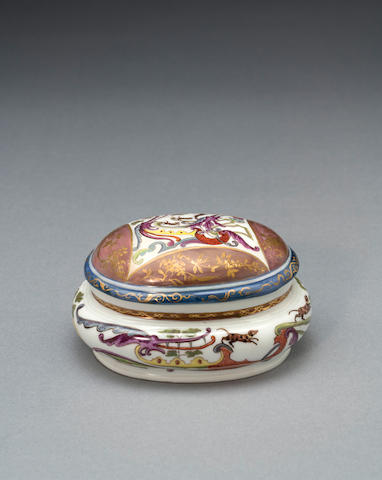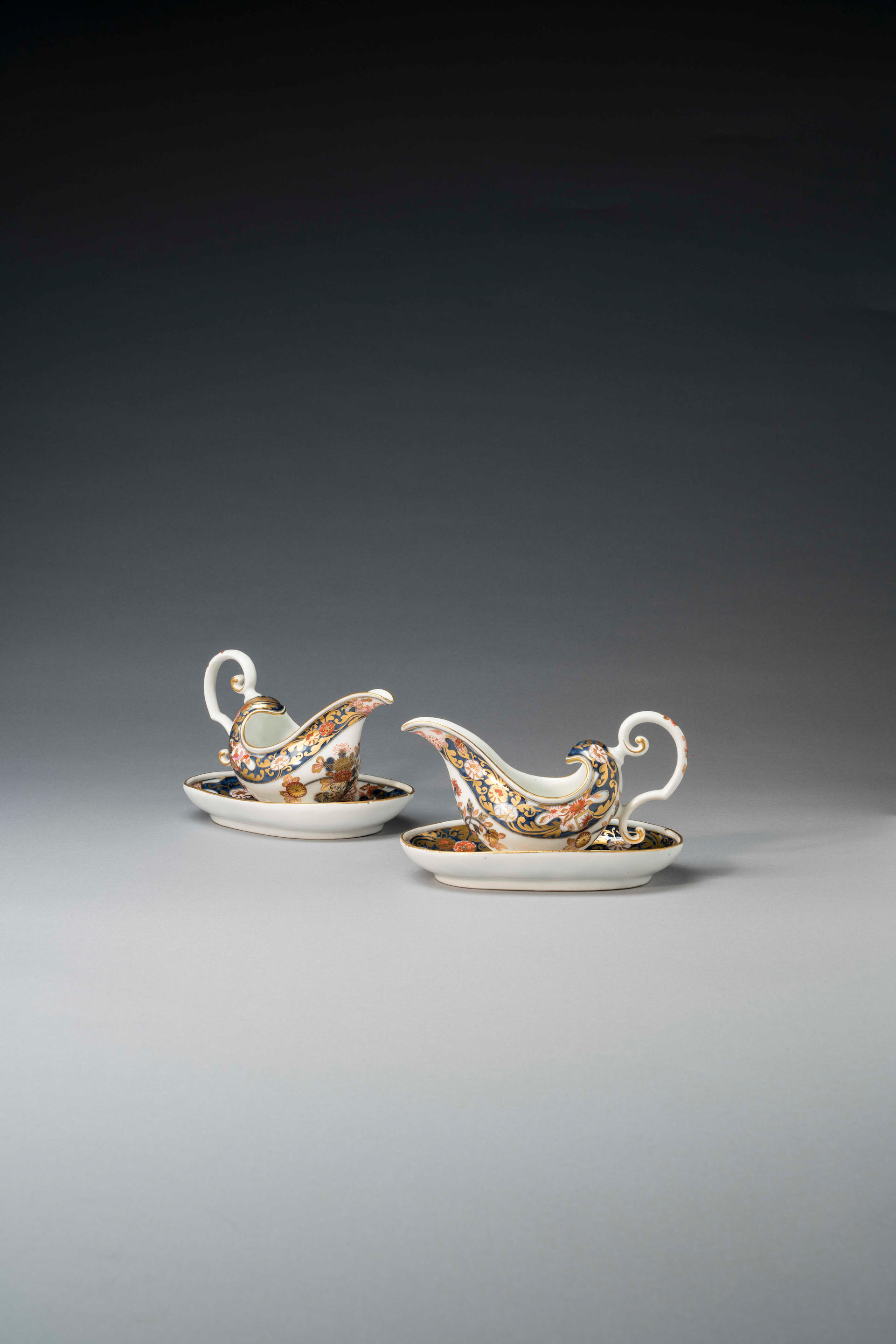An important Meissen bust of the Holy Roman Emperor Charles VII, circa 1742 Probably modelled by J.J. Kaendler and Peter Reinicke wearing a laurel wreath and ermine-lined cloak over a cuirass with lion heads at the shoulders, on a canted, waisted rectangular pedestal moulded with a circular cartouche at the front above the inscription 'CAROLUS VII', 37.7cm high, traces of crossed swords mark in underglaze-blue to rear of base (chips to rear edge of base) Fußnoten Provenance: The Collection of the Counts Waldstein, Dux Castle, Bohemia; Nationalised, circa 1945, thereafter in Hirschberg Castle, Bohemia; Rudolf Just Collection, Prague (acquired at Galerie Horejs in Prague in May 1949 and probably sold by 1967); Anon. sale, Christie's London, 25 February 1991, lot 173 Literature: Gustav Pazaurek, Keramik im Nordböhmischen Gewerbe Museum Reichenberg, in Mitteilungen des Nordböhmischen Gewerbe Museums 23 (1905), p. 113; Rudolf Just, 'Die Kaiserbüsten von Kändler', in Mitteilungsblatt der Keramikfreunde der Schweiz 42 (1958), pp.15-16, ill. 18; Johanna Lessmann, Meissen Porcelain for the Imperial House in Vienna, in M. Cassidy-Geiger (ed.), Fragile Diplomacy Meissen Porcelain for European Courts ca. 1710-63 (2007), p. 134; M. Cassidy-Geiger, The Arnhold Collection of Meissen Porcelain 1710-50 (2008), p. 241, n.10 Exhibition: New York, The Bard Graduate Center, 'Fragile Diplomacy', 15 November 2007-10 February 2008, no. 99 This is the only example of this bust recorded in the literature. See Lessmann (2007), pp. 119-134, for a comprehensive discussion of the series of Meissen busts commissioned in 1744 by the Electress of Saxony and Queen of Poland, Maria Josepha, as a monument to the Habsburg dynasty and its rise to imperial rank (Lessmann, p. 119). With the exception of the present lot, all of the busts depict Habsburg rulers (twelve emperors and five kings). Lessmann notes (p. 119) that it is quite possible that the impetus for the commission came from the court in Vienna; Archduchess Maria Amalia, the Empress Maria Theresia's sister, visited the Meissen manufactory in March 1744 together with her husband, Karl Alexander of Lorraine. The first mention of the busts in the Meissen manufactory work reports is in April 1744 and the last in December 1747 (only nine are specifically referred to). It remains unclear why and when the bust of Charles VII was commissioned. Rudolf Just noted (p. 16) that, as a Bavarian Wittelsbach, Charles VII did not belong to the series of busts of Habsburg rulers, and concluded that it may have been commissioned because the Holy Roman Emperor was married to Maria Josepha's sister and so was a brother-in-law of Maria Josepha and Augustus III. Johanna Lessmann has discussed the anomalous status of the bust in more detail (pp. 122-123), observing that - because of the precarious state of relations between Charles VII, the Habsburg and Saxon/Polish courts - it is unlikely that the bust of the Emperor could have been created much later than early 1742, and raises the possibility that it might have been commissioned to mark his coronation in February 1742, possibly even as a gift from Augustus III. Another possibility, perhaps less likely, is that the bust was commissioned following the Emperor's death on 20th January 1745. Charles VII's successor as Elector of Bavaria, Maximilian III Joseph, concluded a peace treaty with Austria that was signed on 22 April 1745 in Füssen, in which he abandoned his father's claim to Bohemia and recognised the Pragmatic Sanction of 1713. In return, the Austrians acknowledged the legitimacy of Charles VII as Holy Roman Emperor. Charles VII Karl Albrecht of Bavaria (1697-1745) was elected Holy Roman Emperor on 24 January 1742, the first non-Habsburg emperor for three centuries. He married the younger daughter of the Habsburg Emperor Joseph I, Maria Amalia, in 1722. In 1726, he succeeded his father as Elector of Bavaria, while also harbouring ambitions to the imperial throne. To th
An important Meissen bust of the Holy Roman Emperor Charles VII, circa 1742 Probably modelled by J.J. Kaendler and Peter Reinicke wearing a laurel wreath and ermine-lined cloak over a cuirass with lion heads at the shoulders, on a canted, waisted rectangular pedestal moulded with a circular cartouche at the front above the inscription 'CAROLUS VII', 37.7cm high, traces of crossed swords mark in underglaze-blue to rear of base (chips to rear edge of base) Fußnoten Provenance: The Collection of the Counts Waldstein, Dux Castle, Bohemia; Nationalised, circa 1945, thereafter in Hirschberg Castle, Bohemia; Rudolf Just Collection, Prague (acquired at Galerie Horejs in Prague in May 1949 and probably sold by 1967); Anon. sale, Christie's London, 25 February 1991, lot 173 Literature: Gustav Pazaurek, Keramik im Nordböhmischen Gewerbe Museum Reichenberg, in Mitteilungen des Nordböhmischen Gewerbe Museums 23 (1905), p. 113; Rudolf Just, 'Die Kaiserbüsten von Kändler', in Mitteilungsblatt der Keramikfreunde der Schweiz 42 (1958), pp.15-16, ill. 18; Johanna Lessmann, Meissen Porcelain for the Imperial House in Vienna, in M. Cassidy-Geiger (ed.), Fragile Diplomacy Meissen Porcelain for European Courts ca. 1710-63 (2007), p. 134; M. Cassidy-Geiger, The Arnhold Collection of Meissen Porcelain 1710-50 (2008), p. 241, n.10 Exhibition: New York, The Bard Graduate Center, 'Fragile Diplomacy', 15 November 2007-10 February 2008, no. 99 This is the only example of this bust recorded in the literature. See Lessmann (2007), pp. 119-134, for a comprehensive discussion of the series of Meissen busts commissioned in 1744 by the Electress of Saxony and Queen of Poland, Maria Josepha, as a monument to the Habsburg dynasty and its rise to imperial rank (Lessmann, p. 119). With the exception of the present lot, all of the busts depict Habsburg rulers (twelve emperors and five kings). Lessmann notes (p. 119) that it is quite possible that the impetus for the commission came from the court in Vienna; Archduchess Maria Amalia, the Empress Maria Theresia's sister, visited the Meissen manufactory in March 1744 together with her husband, Karl Alexander of Lorraine. The first mention of the busts in the Meissen manufactory work reports is in April 1744 and the last in December 1747 (only nine are specifically referred to). It remains unclear why and when the bust of Charles VII was commissioned. Rudolf Just noted (p. 16) that, as a Bavarian Wittelsbach, Charles VII did not belong to the series of busts of Habsburg rulers, and concluded that it may have been commissioned because the Holy Roman Emperor was married to Maria Josepha's sister and so was a brother-in-law of Maria Josepha and Augustus III. Johanna Lessmann has discussed the anomalous status of the bust in more detail (pp. 122-123), observing that - because of the precarious state of relations between Charles VII, the Habsburg and Saxon/Polish courts - it is unlikely that the bust of the Emperor could have been created much later than early 1742, and raises the possibility that it might have been commissioned to mark his coronation in February 1742, possibly even as a gift from Augustus III. Another possibility, perhaps less likely, is that the bust was commissioned following the Emperor's death on 20th January 1745. Charles VII's successor as Elector of Bavaria, Maximilian III Joseph, concluded a peace treaty with Austria that was signed on 22 April 1745 in Füssen, in which he abandoned his father's claim to Bohemia and recognised the Pragmatic Sanction of 1713. In return, the Austrians acknowledged the legitimacy of Charles VII as Holy Roman Emperor. Charles VII Karl Albrecht of Bavaria (1697-1745) was elected Holy Roman Emperor on 24 January 1742, the first non-Habsburg emperor for three centuries. He married the younger daughter of the Habsburg Emperor Joseph I, Maria Amalia, in 1722. In 1726, he succeeded his father as Elector of Bavaria, while also harbouring ambitions to the imperial throne. To th















Testen Sie LotSearch und seine Premium-Features 7 Tage - ohne Kosten!
Lassen Sie sich automatisch über neue Objekte in kommenden Auktionen benachrichtigen.
Suchauftrag anlegen